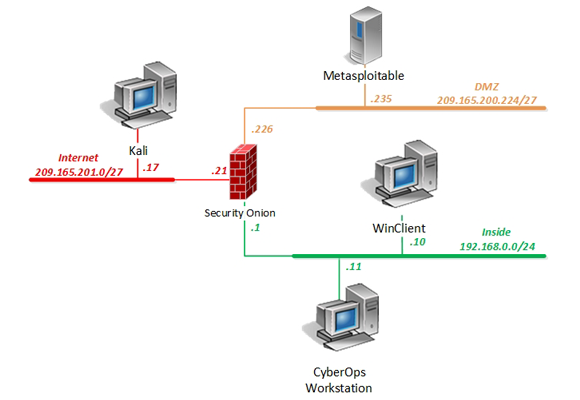This quick reference page provides a summary of the specifications of this topology. For a complete reference including installation details, please refer to the CCNA Cyber Ops Pod Planning and Installation Guide
| Topology | Supports | Documentation |
|---|---|---|

|
CCNA Cyber Ops | Planning and Installation Guide |
You may request virtual machine templates for the CCNA Cyber Ops Pod from CSSIA.

The deployment names of the virtual machines in the CCNA Cyber Ops Pod are provided in the table below.
| VM Name | Virtual Machine Deployment Name |
|---|---|
| CyberOps Workstation | Cisco_CCNA_CyberOps.Workstation |
| Kali | Cisco_CCNA_CyberOps.Kali |
| Metasploitable | Cisco_CCNA_CyberOps.Metasploitable |
| Security Onion | Cisco_CCNA_Cyber_Ops.Security_Onion |
| WinClient | Cisco_CCNA_CyberOps.WinClient |
The CCNA Cyber Ops Pod will consume 37.1 GB of storage per each user pod instance.
Details of the storage requirements for each of the lab virtual machines in the CCNA Cyber Ops Pod are provided in the table below. Some fluctuation in the numbers may occur.
| Virtual Machine | OVF/OVA | Initial Master Pod (thin provisioning) |
|---|---|---|
| CyberOps Workstation | 2.4 GB | 5.7 GB |
| Kali | 3.6 | 8.3 GB |
| Metasploitable | 900MB | 1.8 GB |
| Security Onion | 3.2 GB | 9.7 GB |
| WinClient | 6 GB | 11.6 GB |
| Total | 16.2 | 37.1 |
The virtual machines are made available as Open Virtualization Format (OVF) or Open Virtualization Archive (OVA) files. These files are available for download from EPNC (Education Pathway National Center).
To request access to the preconfigured virtual machine templates from EPNC: